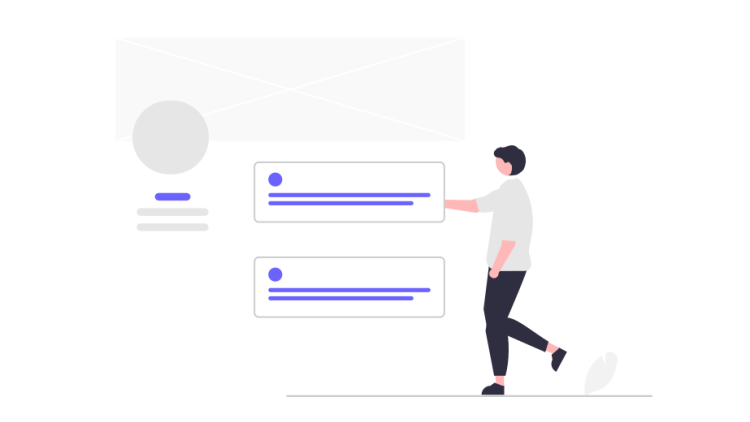Home Page: 5 Social Milestones You Need to Conquer to Land a Sale

Imagine this.
You spend a bunch of money to get website visits.
Perhaps you run an ad campaign, invest in SEO, or host an event that drives traffic.
Visitors get there, and after all the time and money you spend, they leave in two seconds.
Ouch. Everything you put into driving traffic goes to waste.
That happens daily and is so common that it’s the norm. The only thing that can prevent fast bounces is creating a home page that tackles hesitations and connects with visitors immediately.
This isn’t about pain points (which is necessary); however, it’s about fulfilling the subconscious expectations visitors feel when they visit your website for the first time. Excellent copy can fall flat if not combined with foundational social requirements that drive the ultimate click.
One way to picture it is imagining if you visit a website in a language you don’t understand.
What would you look for?
You probably want to know if you should give that company your money and if they would do a good job. It’s that gut feeling you get before making a decision.
This article is about embedding key social checkpoints into your copy and design so you can land the sale. It revolves around five essential themes that visitors will look for. It’s the online version of meeting a prospect at a cocktail party: what do they look for?
1. Gaining trust
The first hesitation when someone visits your website, especially if they don’t know you, is whether they can trust you.
Think of the first time you met with a tax accountant or introduced yourself to a salesperson when buying a car. You try to study the person and see if you can trust them, their advice, and their motives.
It’s the same, and even more intensified, for visitors to your website. You have a bigger barrier to overcome since you aren’t meeting them in person, and instead, the large online arena.
For starters, reviews and testimonials are always helpful. But one way to increase your ability to establish trust is by finding ways to connect with the visitor. People want human connections.

Adding a video walk-through on Loom or a video where you can explain your company’s vision and the solution you offer will go a long way. It feels like meeting someone in person. Adding empathy and heart to your message shows that you want the best for the customer and care about what you do.
2. Proving credibility
I remember hearing a cocky salesman interview a new guy out of college. He said, “I could see myself having a beer with you. A real likable guy. But that doesn’t matter. I need to know if you can sell.”
While the situation made me laugh with the theatrical, stunted way he communicated, the salesman made a good point. People can trust and like you, but they need to know you can do the job well.
Your website should have reviews and testimonials in many different media forms, like videos, written reviews with stars, screenshots of social media posts, and other creative ways to hammer in your reputation.
Depending on what you do, you can also include a portfolio. Whether for photographs of your work, videos, images, graphics, or case studies with statistics, anything you can show will be helpful and establish credibility.
Additionally, as you build a brand on social media, you can add social credibility with your following. You can give away assets and some skilled knowledge that shows authority and encourages people to choose you.
3. Build it with clarity
The biggest mistake I see in the website is the lack of clarity. The headline and subheader are catchy, but you have no idea what the business does. Guess what happens? I, along with everyone else, go right back to Google.
Your header should highlight a magnetic emotional benefit, while the subheading should state exactly what you do.
For example, a boat company that targets families wanting to cruise on the intercoastal might say, “Where Memories Set Sail,” and the subheading will say, “Premium boats for unforgettable family adventures.” One puts you in an emotional state of mind while the other tells you the product they offer.

The rest of the website should be concise, highlight the benefits and features, and direct traffic to make one decision.
4. Position yourself
Your website should position itself for your target audience with the best solution to their problem.
By being very specific, you can increase your sales price since you are perceived to be a specialized business. For example, you could be a developer. Or, you could be a developer for enterprise payment processing companies. You get a lot more leverage the more specific your solution is.
You are also more likely to increase conversions when visitors see you as the most qualified solution for them and their needs.
5. Show results
Your home page should state tangible results customers expect from you. If it is a service, highlight the results they can expect. If it is a product, highlight the product they received and the emotional benefits they feel after they use it.
By implementing these elements into your home page, you can increase sales and build a powerful website for your visitors that drives action.
TL;DR

When you build or improve your home page, focus on these elements:
- Trust
- Credibility
- Clarity
- Positioning
- Results
John Paul Hernandez writes B2B content that engages customers and moves them to action. He builds authoritative digital assets designed to connect with audiences. You can find out more about John Paul on his website or X.